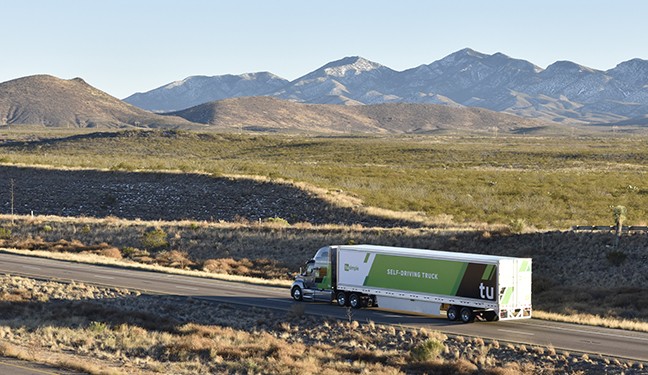On Aug. 10, 2018, a semi-truck drove between Tucson and Phoenix without any human intervention. That truck will grow into a fleet of 50 vehicles by June.
These long-haul semi-trucks, operated and programmed by technology company TuSimple, still have humans onboard in case of an emergency. But that may not be the case for long.
"We are actively sorting out our schedule, and aiming for 2020 or early 2021 to deliver fully-automated vehicles," said Vivian Sun, senior director of business development at TuSimple.
The company's mission is to bring the first self-driving truck to the market. According to them, this would increase safety, decrease transportation costs and reduce carbon emissions. But how will these technological advancements affect Tucson, and can they coexist with the multiple long-haul trucking agencies in town?
TuSimple's autonomous semi-trucks currently have two humans onboard: an engineer and a driver. But depending on future regulations and their customer's wishes, TuSimple may completely remove humans from the driving process by as early as next year.
The trucks, which use Peterbilt bodies, are equipped with multiple cameras and sensors. They can perceive 1,000 meters down the road, navigate complex roadways and operate rain or shine. The trucks have completed trips from Tucson to Phoenix, Nogales and even El Paso, Texas. And it's not just highway driving, TuSimple's trucks can drive from depot to depot, both on highways and local roads.
While this development might pose a real risk of putting truck drivers out of jobs, it may in fact fix a growing shortage of drivers across the country. In 2017, the American Trucking Association reported the trucking industry was short roughly 50,000 drivers. Estimates also include the shortage growing to more than 174,000 by 2026. ATA blamed these shortages on "aging driver population, lifestyle issues, regulatory challenges" and more.
"It's a common question we always get: What about truckers' jobs?" Sun said. "Truck driving is a very large pool, and there's all sorts of skill needed."
TuSimple has expanded its Tucson warehouse this year while on a mission to eventually grow its autonomous truck fleet to 200 and add roughly 500 new jobs over the next two years. TuSimple currently employs more than 100 workers in Tucson, mostly in the mechanical and software engineering fields.
These are high-paying engineering jobs, many of which come directly from the University of Arizona. TuSimple's expanding presence in town is estimated to create an economic impact of over $1 billion in the next five years.
"I think it's the natural transition of technologies in society," said Larry Head, interim dean of the UA College of Engineering. "It may reroute jobs, but there's always going to be a need for humans in these systems."
Head serves on the Arizona Governor's Task Force for Self-Driving Vehicles and has over 25 years of systems engineering experience related to automated vehicle systems. He said that while the technology is not perfect, and it will be a while before it is perfected, there are already many benefits to the automated systems.
With the concept of autonomous vehicles becoming mainstream, the National Highway Traffic Safety Administration developed a chart detailing "six levels of driver assistance technology." The levels range from zero, where this is no automation, to five, where the vehicle is capable of performing all driving functions.
TuSimple's trucks are currently driving at level four, known as "high automation," in which the vehicle is capable of performing all driving functions, but only under certain conditions, such as only on specific routes. According to Sun, complete level five is not necessary at this time for TuSimple.
"The technology is not at level five, but improvements are being made and getting closer," said Mathieu Joerger, Ph.D., an assistant professor of aerospace and mechanical engineering at UA. "We're on the path to full automation."
Joerger's research focuses on using aircraft navigation safety standards to ensure the safety of autonomous vehicles. Safety is one of the most emphasized benefits of autonomous vehicles. And while Joerger said there are many benefits to automation, he also believes safely taking humans out of vehicles is a huge challenge.
"The challenge is not whether you can get an autonomous vehicle to go from L.A. to New York, the challenge is whether you can safely do it a million times," Joerger said.
Human drivers cause traffic fatalities roughly once per 100 million miles of driving, whereas the aircraft safety standards Joerger works with cannot accept crashes even in one out of one billion landings.
"These trucks can drive on the highway for 26 hours, whereas a human can only drive for eight before being required to take a break," Head said. "Autonomous technology has the possibility to be much safer and more efficient."
Employees at multiple local trucking agencies are not concerned about automation, as these systems have not yet impacted their business.
“With the new technology being used in today’s workforce, automated vehicles are definitely a natural change to the transportation industry and was bound to happen,” said Doug Prall, owner of Digby Southwest, an over-the-road trucking company with service terminals located in Tucson and Phoenix. “I don’t see it as a threat, but rather, an enhancement.”
Prall says automated trucks have not impacted Digby Southwest yet, as the industry is still too new. But even as automation inevitably advances, he isn’t concerned, as he says automation will help reduce the driver shortage and increase safety.
“We have very few concerns,” Prall said.
In addition, training and certification programs are integral to the trucking industry. These programs may be altered and updated to align with automation.
"So long as humans have a role to play in a driving task, they will have to be able to take over," Joerger said. "Some researchers suggest you might even need a very special license to operate an automated vehicle, because of the complex systems involved."
While this might seem paradoxical—a driver needing additional training to even potentially operate a vehicle able to drive itself—it is one of the key reasons behind a new collaboration between TuSimple and Pima Community College: an autonomous vehicle driver and specialist certificate program.
"What's different for each of our programs is when software comes into play," said Greg Wilson, Dean of Applied Technology at PCC. "Even in a subject like welding, where you think it's not involved with software, that's not necessarily the case... I can't think of any area where you're not going to be at least interacting with a computer."
PCC offers numerous career training and certification programs, even working with companies like Raytheon and Caterpillar to update employee skill sets. And while training truck drivers on autonomous vehicles, a subject far removed from their traditional employment, might seem difficult, PCC boasts a 90 percent completion rate for their career training programs.
"A large portion of our student population are transitioning adults who are either looking for a change, or are looking to increase their skills at their current position," Wilson said. "Industry drives what we do at the college. And our programs really reflect what's happening with industry. We're on parallel tracks."
Looking forward, TuSimple plans to increase their overall reliability and safety by increasing the number of routes driven, as well as the number of possible scenarios on the road. TuSimple is also in talks with transportation companies that own truck fleets, both to switch to autonomous vehicles, as well as possibly training their drivers for handling autonomous systems.
"There is a whole variety of scenarios we have to handle very gracefully," Sun said. "We do believe our trucks have the opportunity to coexist with other drivers on the road. Both other drivers and other trucks."














